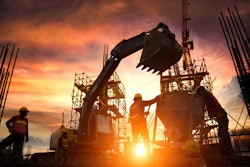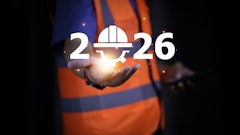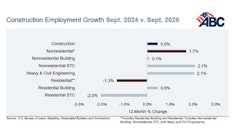
As someone who's spent over two decades studying workforce dynamics, I've never seen a more complex talent landscape than what we're facing in construction today. With open jobs plummeting 40% year-over-year, you might think we're simply dealing with another cyclical downturn. But this isn't your typical market correction — it's a wake-up call for an industry that's trying to solve 2025's challenges using 1995's playbook.
What does the alarm bell sound like? Only 3.4% of industrywide positions are currently open, the lowest since 2020. While economic headlines and rising borrowing costs typically get the blame, I'm seeing something deeper in my work with construction leaders. This labor shortage is a reflection of a larger issue: a leadership identity crisis.
Many companies, naturally, are hunkering down, waiting for market conditions to improve before making critical hiring decisions. But the real opportunity is fundamentally reimagining how we attract, retain, and optimize talent to secure a competitive advantage. Why? Well, the construction industry has always prided itself on building things that last. Yet when it comes to building lasting teams and organizations, too many of us are using outdated blueprints.
It's time to put down the "tough it out" toolbox and pick up something more powerful: behavioral intelligence. Because in today's market, the most successful businesses will be those that understand and work with the human element of the job site, not those with the deepest pockets, biggest equipment fleet or glitzy tech.
The Traditional Playbook is Failing
The best construction leaders I know constantly question old assumptions about talent. While market conditions matter, winning firms are exploring smarter ways to attract and keep skilled workers. That means looking beyond the basics of pay and benefits to understand what actually drives performance on modern job sites.
Bureau of Labor Statistics data from December 2024 reveals a key insight into our industry's current trajectory. As residential construction slows, nonresidential projects are fueling 3.7% employment growth. Smart firms see this split market as an ideal time to strengthen their teams and refine their talent approach.
Here's what I see happening on job sites across the country: A veteran foreman brings decades of hard-earned wisdom and problem-solving skills. His millennial project coordinator introduces new digital solutions that boost efficiency. The superintendent connecting them sees opportunities in both approaches. When these perspectives align, the results are impressive.
Three different generations, three valuable approaches to getting work done. Your experienced workers excel at hands-on problem-solving and mentoring. Your younger talent drives innovation and fresh thinking. And those mid-career leaders? They're masterful at bringing these strengths together.
When construction firms embrace diverse work styles and perspectives, the impact ripples across every aspect of operations. Safety improves because teams communicate better. Problem-solving gets sharper as different viewpoints surface solutions. Project quality rises when everyone brings their strengths to the table.
Behavioral Data: The Missing Data Link in Modern Construction
A mid-sized general contracting firm in Chicago was wrestling with the industry's biggest challenges: high turnover, team friction, and the endless cycle of replacing skilled workers. But instead of accepting these problems as inevitable, they turned to behavioral data for answers.
By implementing behavioral assessments, this firm gained insights into how their people naturally work, communicate, and solve problems. The results speak volumes. They cut their attrition rate by 4%, saving roughly $180,000 annually in turnover costs. More importantly, they discovered something powerful about their team composition.
Take their crew assignments, for example. Instead of just matching skills to tasks, they started considering behavioral fits. They paired detail-oriented superintendents with big-picture project managers. They matched methodical safety coordinators with dynamic site supervisors. These changes resulted in better communication, fewer conflicts, and projects that ran smoother.
This approach matters even more in today's multi-generational workforce. When you understand that your veteran foreman's methodical approach complements your millennial project coordinator’s innovative mindset, you stop seeing generational gaps and start seeing opportunities for collaboration.
Sometimes, simple math is hard to see. Replacing a skilled construction worker costs between 50% and 200% of their annual salary, but this doesn’t count the hidden costs of lost productivity and team disruption. When firms apply behavioral insights to their hiring and team-building, they can expect improved engagement, presenteeism, and retention, which can have a dramatic impact on the bottom line.
Building a Future-Ready Construction Workforce
Want to know what sets top construction firms apart in 2025? It's not their equipment or their technology — it's their ability to build an intentional culture where people feel valued and want to stay. Here's what that looks like in practice:
- Psychological Safety Drives Better Projects: When workers feel secure enough to speak up about safety concerns or suggest process improvements, projects run better. Sites with strong psychological safety see fewer accidents and faster problem resolution because people don't hesitate to raise red flags or share better solutions.
- Human Connection Matters More Than Ever: Technology is transforming our sites, but success still hinges on relationships. The most effective teams find the sweet spot between digital efficiency and personal interaction. Your best crew leaders know when to rely on project management software and when a face-to-face conversation will get better results.
- Flexibility Opens New Doors: Even in construction, where much work requires being on-site, flexibility matters, especially to the 91% of leaders who see it as key to satisfaction. Office staff, project managers, and estimators often can split time between site and home without impacting quality. The key is matching work arrangements to both project needs and individual work styles.
Modern construction blends proven practices with fresh thinking to build teams that can handle whatever the market throws at them.
The 2025 Game Plan
Let's cut through the complexity and focus on three actions you need to take now to prepare for 2025's construction demands:
First, map your team's behavioral patterns. Identify who thrives under pressure, who excels at detailed planning, and who builds the strongest relationships with clients and subcontractors. Understanding how your people naturally work helps you leverage their strengths across projects.
Second, invest in your frontline leaders' people skills. Your superintendents and foremen shape daily site culture. Give them tools to read team dynamics, manage conflicts, and build psychological safety. Both technical expertise and people management determine project success.
Third, build flexibility into your operations where it makes sense. Review which roles truly need full-time site presence and where hybrid arrangements could work. Smart flexibility means giving your people the autonomy to deliver their best work while maintaining project momentum.
The construction firms that will achieve lasting prosperity recognize that success depends on understanding their people's capabilities and creating environments where those capabilities flourish. Start building that foundation now.




















